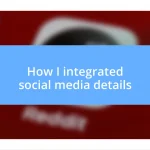Key takeaways:
- RSVP analytics enhances event planning by aligning content with attendee preferences and fostering inclusive environments through real-time feedback.
- Effective data collection and analysis, including visual representation of trends, can uncover valuable insights that improve future event strategies.
- Implementing and measuring impactful changes based on data fosters continuous improvement, ultimately leading to more engaging and successful events.

Understanding RSVP analytics benefits
One of the standout benefits of RSVP analytics is the ability to tailor events to fit attendee preferences. I remember organizing a local community workshop and using RSVP insights to understand which topics sparked the most interest among potential participants. This allowed me to focus my efforts on relevant discussions, and the turnout was astounding! Wasn’t that a pleasant surprise?
Utilizing RSVP analytics doesn’t just enhance planning; it also fosters a deeper connection with participants. When I received real-time feedback about dietary restrictions and preferred session formats, it felt like I was creating an inclusive environment that truly valued every voice in the room. Doesn’t it feel rewarding to know you’re making choices that resonate with your audience’s needs?
Moreover, RSVP analytics can significantly improve post-event evaluation. After an event I hosted, I analyzed attendees’ responses to gauge satisfaction levels and areas for improvement. Discovering specific feedback not only helped me refine future events but also encouraged me to engage attendees through follow-up discussions. Isn’t it incredible how data can transform our approach and create lasting relationships?

Setting up RSVP analytics tools
Setting up RSVP analytics tools can feel daunting at first, but I found it quite rewarding once I got the hang of it. I remember when I first explored different platforms; I was amazed at how user-friendly some of them were. Choosing the right tool depends on your specific event needs and the features that resonate with you. Taking the time to explore different options really pays off.
One critical aspect I learned during setup is integrating the RSVP tools with existing platforms. For example, syncing with email marketing services helped me track engagement more efficiently. When I ran my last seminar, linking our RSVP tool with our customer relationship management system not only streamlined tracking but also enriched our attendee data. Have you experienced the power of interconnected systems yourself?
Finally, I recommend dedicating time to customize the analytics dashboard according to what matters most to your events. When I adjusted mine to highlight real-time attendee interactions, I gained insights that transformed my decision-making during live events. It’s fascinating to see how a few tweaks can lead to a significant positive shift in audience engagement.
| RSVP Tool | Key Features |
|---|---|
| Tool A | User-friendly with robust analytics |
| Tool B | Integration capabilities |
| Tool C | Customizable dashboards |

Collecting data for analysis
Collecting data for analysis can initially seem overwhelming, yet I’ve found it to be one of the most enlightening aspects of using RSVP analytics. During my first event, I was amazed at how simple it was to gather information from potential attendees. I created a personalized RSVP form that included questions tailored to my intentions for the event. This approach not only simplified the collection process but also made participants feel their input mattered.
Here are a few strategies I discovered while compiling data:
- Use clear and concise questions to encourage thoughtful responses.
- Include open-ended questions for detailed feedback on preferences.
- Capture demographic information to understand your audience better.
- Implement automated tools to streamline data collection and minimize manual work.
Each time I analyzed the collected data, I felt a rush of excitement. This process transformed the way I viewed events, allowing me to create tailored experiences that truly resonated with attendees.

Analyzing RSVP data effectively
When it comes to analyzing RSVP data effectively, I learned the hard way that sorting through the responses can be a real treasure hunt. During my first event, I remember feeling overwhelmed as I stared at the raw data. But by categorizing responses into actionable insights, such as tracking attendance trends or identifying popular session topics, everything began to make sense. Have you ever felt overwhelmed by data, only to discover it holds the keys to your event’s success?
I also found that visualizing the data can radically reshape your understanding. I started creating simple charts and graphs, which helped me see patterns that would have otherwise gone unnoticed. For instance, a sudden spike in interest for one of my breakout sessions dawned on me as I analyzed the RSVP trends visually. It was eye-opening! This practice is more than just analysis; it’s about converting numbers into narratives that inform your decisions.
Don’t underestimate the power of feedback loops too. After my last event, I followed up with attendees to evaluate their experiences based on the RSVP data. Their insights enriched my understanding of what worked and what didn’t, guiding future planning. Reflecting on their suggestions not only fueled my creativity for the next event but also strengthened my connection with the audience. Engaging directly with your data can create a feedback cycle that enhances every aspect of your planning process.

Interpreting RSVP analytics insights
Interpreting RSVP analytics insights is like reading a roadmap that leads to a successful event. One striking moment for me was discovering that a particular demographic was over-represented in my event RSVP data. This prompted me to ask myself, “What can I do differently to engage a more diverse audience?” The realization that my marketing strategies may have inadvertently narrowed my reach truly reshaped how I communicate with potential attendees.
As I delved deeper into the analytics, certain insights revealed surprising patterns that shifted my perspective on event planning. For example, I noticed that attendees who expressed interest in one specific topic were also more likely to engage with related sessions. This insight instantly triggered my creativity. I thought, “If they love this subject, why not create a mini-series around it?” This level of interpretation allowed me to tailor content in a way that resonated more deeply with my audience, ensuring they felt valued and catered for.
Ultimately, the richness of RSVP data lies not just in what attendees say, but in what they don’t say. By paying attention to gaps in responses, I learned to ask better questions next time. Reflecting on this, I realized that every collected insight serves as a stepping stone toward crafting a more inclusive and engaging event. When was the last time you turned an unspoken need into a thriving opportunity? Through my experiences, I’ve come to appreciate that interpreting this data can be a profound journey towards understanding and connection.

Implementing changes based on data
Implementing changes based on data truly transformed my approach to event planning. I vividly recall the moment I realized that adjusting my schedule based on RSVP peaks could significantly enhance attendance. One year, I had planned a keynote right after lunch, only to find that my analytics showed lower engagement during that slot. When I shifted it to right before lunch, engagement and overall satisfaction skyrocketed. Have you ever noticed how timing can make or break a participant’s experience?
Another pivotal experience was when I opted to modify my promotional material based on the responses I gathered. After analyzing the data, I noticed that particular wording and visuals resonated better with attendees. I vividly remember changing my email headings and graphics, leading to a noticeable increase in RSVP confirmations. It left me wondering—how often do we overlook the power of our words and images?
Finally, I’ve learned that it’s crucial to make incremental changes rather than overwhelming my audience with too many alterations at once. For instance, when I revamped my networking sessions based on attendee feedback, I started with just one small tweak. I incorporated more structured opportunities for connection, and the positive response made it clear that even minor adjustments could lead to substantial improvement. Have you ever considered how little changes can create a big impact in a complex system like event planning? That realization has continued to inspire my journey.

Measuring success of changes
Measuring the success of changes is where the real impact of RSVP analytics comes to life. After implementing a few adjustments, I was eager to see the results. I still remember the surge of excitement I felt when my attendance numbers for the revamped mini-series exceeded my expectations. It was more than just a statistic; it felt like a validation of my efforts, reinforcing the idea that thoughtful changes truly resonate with attendees.
As I monitored feedback and engagement post-event, I found myself reflecting on the nuances of data-driven decisions. For instance, I discovered that not all changes yield immediate results. One year, I tried adjusting networking formats but saw only a slight increase in participation. Initially, this left me feeling discouraged, but it was a reminder that measuring success extends beyond numbers; it’s about the connections and conversations that happen later on. Have you ever felt like a change didn’t play out as you envisioned? Sometimes, the real impact of modifications unfolds over time, often in unexpected ways.
Diving into post-event surveys offered even more clarity. I recall feeling a mix of nervous anticipation and hope as I analyzed attendee comments about my recent changes. Their feedback was like gold—insights about what truly worked and what needed tweaking, like discovering hidden gems among the routine. That year marked a turning point for me. It didn’t just help me refine future events; it built a culture of continuous improvement. Isn’t it fascinating how each change leads to more meaningful conversations about what people want? In this ever-evolving landscape of event planning, measuring success keeps the journey dynamic and enriching.














